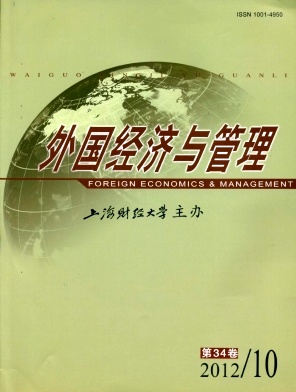基于高管团队领导权配置视角的企业战略柔性研究前沿探析
外国经济与管理 2012 年 第 34 卷第 10 期, 页码:57 - 66
摘要
参考文献
摘要
在复杂多变的环境中,战略柔性是企业可持续发展的活力之源。本文在梳理企业战略柔性研究脉络的基础上,首先明晰了高管团队领导权配置对企业构建战略柔性的驱动源作用,然后分别从高管团队及其成员的领导权来源、运用和匹配三个方面逐层深入,探究了高管团队整体层面的领导自主权水平和成员之间的领导权内部分布对于企业战略柔性的作用机理,最后对未来研究方向做了简要展望。
[1]Aaker D A and Mascarenhas B.The need for strategic flexibi-lity[J].Journal of Business Strategy,1984,5(2):74-82.
[2]Ansoff H I.Strategic issue management[J].Strategic Manage-ment Journal,1980,1(2):131-148.
[3]Augier M and Teece D J.Dynamic capabilities and the role of managers in business strategy and economic performance[J].Organization Science,2009,20(2):410-421.
[4]Carmeli A,et al.How CEO empowering leadership shapes top management team processes:Implications for firm perfor-mance[J].Leadership Quarterly,2011,22(2):399-411.
[5]Carpenter M A and Golden B R.Perceived managerial discre-tion:A study of cause and effect[J].Strategic Management Journal,1997,18(3):187-206.
[6]Dewett T.Creativity and strategic management:Individual and group considerations concerning decision alternatives in the top management teams[J].Journal of Managerial Psychology,2004,19(2):156-169.
[7]Eisenhardt K M and Bourgeois III L J.Politics of strategic de-cision making in high-velocity environments:Toward a midrange theory[J].Academy of Management Journal,1988,31(4):737-770.
[8]Ensley M D,et al.The importance of vertical and shared lea-dership within new venture top management teams:Implica-tions for the performance of startups[J].Leadership Quarter-ly,2006,17(3):217-231.
[9]Evans J S.Strategic flexibility for high technology manoeuvres:A conceptual framework[J].Journal of Management Studies,1991,28(1):69-89.
[10]Finkelstein S.Power in top management teams:Dimensions,measurement,and validation[J].Academy of Management Journal,1992,35(3):505-538.
[11]Finkelstein S and Peteraf M A.Managerial activities:A mis-sing link in managerial discretion theory[J].Strategic Organi-zation,2007,5(3):237-248.
[12]Greve H R and Mitsuhashi H.Power and glory:Concentrated power in top management teams[J].Organization Studies,2007,28(8):1197-1220.
[13]Haleblian J and Finkelstein S.Top management team size,CEO dominance,and firm performance:The moderating roles of environmental turbulence and discretion[J].Academy of Management Journal,1993,36(4):844-863.
[14]Hambrick D C.Upper echelons theory:An update[J].Academy of Management Review,2007,32(2):334-343.
[15]Hambrick D C and Abrahamson E.Assessing managerial dis-cretion across industries:A multimethod approach[J].Aca-demy of Management Journal,1995,38(5):1427-1441.
[16]Hambrick D C and Finkelstein S.Managerial discretion:A bridge between polar views of organizational outcomes[J].Research in organizational behavior,1987,9(2):369-406.
[17]Hitt M A,et al.Navigating in the new competitive land-scape:Building strategic flexibility and competitive advantage in the21st century[J].Academy of Management Executive,1998,12(4):22-42.
[18]Karri R V N.Strategic flexibility and firm performance[D].Washington State University,2001.
[19]Lee H-U.The impact of CEO and TMT characteristics on strategic flexibility and firm performance[D].Texas A&M University,2002.
[20]Li J and Tang Y.CEO hubris and firm risk taking in China:The moderating role of managerial discretion[J].Academy of Management Journal,2010,53(1):45-68.
[21]Nadkarni S and Herrmann P O L.CEO personality,strategic flexibility,and firm performance:The case of the Indian busi-ness process outsourcing industry[J].Academy of Manage-ment Journal,2010,53(5):1050-1073.
[22]Nadkarni S and Narayanan V K.Strategic schemas,strategic flexibility,and firm performance:The moderating role of in-dustry clockspeed[J].Strategic Management Journal,2007,28(3):243-270.
[23]Pfeffer J.Power in organizations[M].Marshfield,MA:Pit-man Publishing,1981.
[24]Peterson R S,et al.Group dynamics in top management teams:Groupthink,vigilance,and alternative models of or-ganizational failure and success[J].Organizational Behavior and Human Decision Processes,1998,73(2/3):272-305.
[25]Sanchez R.Strategic flexibility in product competition[J].Strategic Management Journal,1995,16(S.I.):135-159.
[26]Shimizu K and Hitt M A.Strategic flexibility:Organizationalpreparedness to reverse ineffective strategic decisions[J].A-cademy of Management Executive,2004,18(4):44-59.
[27]Wernerfelt B and Karnani A.Competitive strategy under un-certainty[J].Strategic Management Journal,1987,8(2):187-194.
[28]Zhao X P,et al.Perceived managerial discretion and firm per-formance:The moderating role of market competition[J].So-cial Behavior and Personality:An International Journal,2010,38(2):145-157.
[29]李有根,赵锡斌.国外经理自主权研究及测量[J].外国经济与管理,2003,(12):2-6.
[30]刘益,李垣,汪应洛.柔性战略的理论、分析方法及其应用[M].北京:中国人民大学出版社,2005.
[2]Ansoff H I.Strategic issue management[J].Strategic Manage-ment Journal,1980,1(2):131-148.
[3]Augier M and Teece D J.Dynamic capabilities and the role of managers in business strategy and economic performance[J].Organization Science,2009,20(2):410-421.
[4]Carmeli A,et al.How CEO empowering leadership shapes top management team processes:Implications for firm perfor-mance[J].Leadership Quarterly,2011,22(2):399-411.
[5]Carpenter M A and Golden B R.Perceived managerial discre-tion:A study of cause and effect[J].Strategic Management Journal,1997,18(3):187-206.
[6]Dewett T.Creativity and strategic management:Individual and group considerations concerning decision alternatives in the top management teams[J].Journal of Managerial Psychology,2004,19(2):156-169.
[7]Eisenhardt K M and Bourgeois III L J.Politics of strategic de-cision making in high-velocity environments:Toward a midrange theory[J].Academy of Management Journal,1988,31(4):737-770.
[8]Ensley M D,et al.The importance of vertical and shared lea-dership within new venture top management teams:Implica-tions for the performance of startups[J].Leadership Quarter-ly,2006,17(3):217-231.
[9]Evans J S.Strategic flexibility for high technology manoeuvres:A conceptual framework[J].Journal of Management Studies,1991,28(1):69-89.
[10]Finkelstein S.Power in top management teams:Dimensions,measurement,and validation[J].Academy of Management Journal,1992,35(3):505-538.
[11]Finkelstein S and Peteraf M A.Managerial activities:A mis-sing link in managerial discretion theory[J].Strategic Organi-zation,2007,5(3):237-248.
[12]Greve H R and Mitsuhashi H.Power and glory:Concentrated power in top management teams[J].Organization Studies,2007,28(8):1197-1220.
[13]Haleblian J and Finkelstein S.Top management team size,CEO dominance,and firm performance:The moderating roles of environmental turbulence and discretion[J].Academy of Management Journal,1993,36(4):844-863.
[14]Hambrick D C.Upper echelons theory:An update[J].Academy of Management Review,2007,32(2):334-343.
[15]Hambrick D C and Abrahamson E.Assessing managerial dis-cretion across industries:A multimethod approach[J].Aca-demy of Management Journal,1995,38(5):1427-1441.
[16]Hambrick D C and Finkelstein S.Managerial discretion:A bridge between polar views of organizational outcomes[J].Research in organizational behavior,1987,9(2):369-406.
[17]Hitt M A,et al.Navigating in the new competitive land-scape:Building strategic flexibility and competitive advantage in the21st century[J].Academy of Management Executive,1998,12(4):22-42.
[18]Karri R V N.Strategic flexibility and firm performance[D].Washington State University,2001.
[19]Lee H-U.The impact of CEO and TMT characteristics on strategic flexibility and firm performance[D].Texas A&M University,2002.
[20]Li J and Tang Y.CEO hubris and firm risk taking in China:The moderating role of managerial discretion[J].Academy of Management Journal,2010,53(1):45-68.
[21]Nadkarni S and Herrmann P O L.CEO personality,strategic flexibility,and firm performance:The case of the Indian busi-ness process outsourcing industry[J].Academy of Manage-ment Journal,2010,53(5):1050-1073.
[22]Nadkarni S and Narayanan V K.Strategic schemas,strategic flexibility,and firm performance:The moderating role of in-dustry clockspeed[J].Strategic Management Journal,2007,28(3):243-270.
[23]Pfeffer J.Power in organizations[M].Marshfield,MA:Pit-man Publishing,1981.
[24]Peterson R S,et al.Group dynamics in top management teams:Groupthink,vigilance,and alternative models of or-ganizational failure and success[J].Organizational Behavior and Human Decision Processes,1998,73(2/3):272-305.
[25]Sanchez R.Strategic flexibility in product competition[J].Strategic Management Journal,1995,16(S.I.):135-159.
[26]Shimizu K and Hitt M A.Strategic flexibility:Organizationalpreparedness to reverse ineffective strategic decisions[J].A-cademy of Management Executive,2004,18(4):44-59.
[27]Wernerfelt B and Karnani A.Competitive strategy under un-certainty[J].Strategic Management Journal,1987,8(2):187-194.
[28]Zhao X P,et al.Perceived managerial discretion and firm per-formance:The moderating role of market competition[J].So-cial Behavior and Personality:An International Journal,2010,38(2):145-157.
[29]李有根,赵锡斌.国外经理自主权研究及测量[J].外国经济与管理,2003,(12):2-6.
[30]刘益,李垣,汪应洛.柔性战略的理论、分析方法及其应用[M].北京:中国人民大学出版社,2005.
引用本文
刘兵, 李嫄, 郭然. 基于高管团队领导权配置视角的企业战略柔性研究前沿探析[J]. 外国经济与管理, 2012, 34(10): 57–66.
导出参考文献,格式为:
下一篇:国外消费者自我赠礼研究进展探析





 8700
8700  824
824

